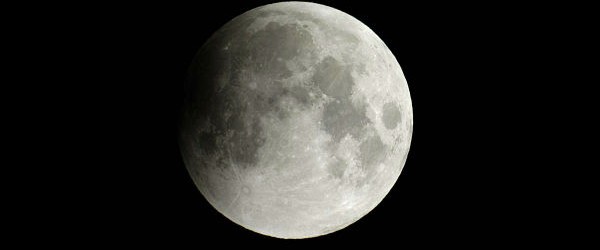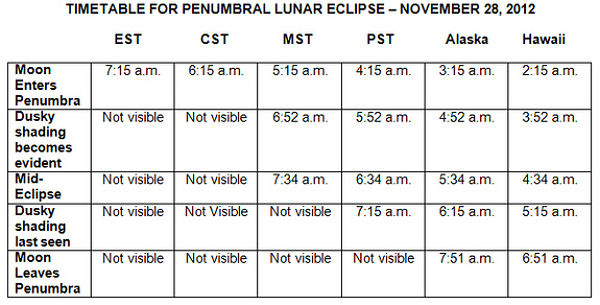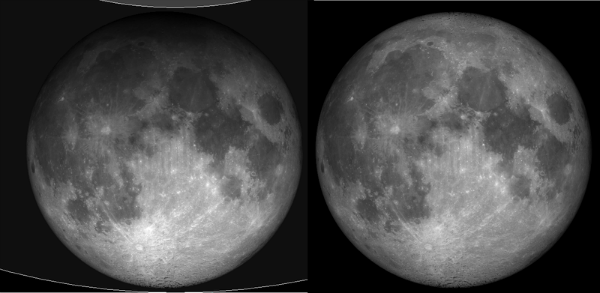Source: The Watchers, by Chillymanjaro, 11/27/12

On November 28, 2012 the moon will slide through the Earth’s pale outer shadow or penumbra, resulting in a penumbral lunar eclipse. A penumbral lunar eclipse occurs when the Earth moves between the Sun and Moon but the three celestial bodies do not form a perfectly straight line. The Earth revolves around the Sun and the Moon circles the Earth. During Full Moon, the Earth passes roughly between Moon and Sun.
First penumbra contact will occur at 12:15 UTC (7:15 a.m. EST). A weak penumbral eclipse of the Moon occurs before and/or during dawn Wednesday morning for western North America. You should look for a weak shading on the Moon’s north or upper right side. The farther in from the West Coast you are, the brighter the dawn and the lower the Moon will be. The penumbral eclipse takes place high in the middle of the night for the longitudes of Australia and Japan, in late evening of the 28th local date for China and Southeast Asia, and early that evening for India with the Moon still low in the east.
Eastern Canada and the USA will miss the eclipse entirely since it begins after moonset. Observers in western Canada and the USA will have the best views with moonset occurring sometime after mid-eclipse. To catch the entire event, one must be in Alaska, Hawaii, Australia, or East Asia.
Penumbral Lunar Eclipse of November 28 visibility map (“Five Millenium Canon of Lunar Eclipses” Espenak & Meeus / NASA)
This chart depicts the penumbral lunar eclipse viewing times in the United States for the Nov. 28, 2012, lunar eclipse. (Credit: Joe Rao – Hayden Planetarium/SPACE.com)
Observers on the southern hemisphere stand “upside-down” compared to observers on the northern hemisphere, so they also see the Moon “upside-down”. The orientation of a lunar eclipse and the direction in which the shadow appears to move across the Moon’s surface can therefore vary according to latitude.
Slooh Space Camera will webcast live from Canary Islands.
A total penumbral lunar eclipse dims the moon in direct proportion to the area of the sun’s disk blocked by the Earth. This comparison shows the southern shadow penumbral lunar eclipse of January 1999 (left) to the same moon outside of the shadow (right) demonstrates this subtle dimming. (Credit: Wikipedia)
How to Photograph the Lunar Eclipse
The moon will be full and at its apogee at the time of eclipse. Apogee is farthest point in its orbit from Earth. The moon will be positioned 6 degrees northwest of Aldebaran and about 8 degrees west of Jupiter, located in the constellation Taurus. You can spot dimmer Pleiades above them.
Penumbral Lunar Eclipse of November 28
“Five Millennium Canon of Lunar Eclipses: -1999 to +3000“
The November 28 penumbral lunar eclipse is the 11th member of Saros 145, a series of 71 eclipses in the following sequence: 18 penumbral, 10 partial, 15 total, 20 partial, and 8 penumbral lunar eclipses. Lunar eclipses of Saros 145 all occur at the Moon’s descending node and the Moon moves northward with each eclipse. The series began with a penumbral eclipse near the southern edge of the penumbra on August 11, 1832. The series will end with a penumbral eclipse near the northern edge of the penumbra on September 16, 3094. The total duration of Saros series 145 is 1262.11 years.
All Eclipses from 1900 to 2100
Featured image: Deep penumbral lunar eclipse in 2004 (Photo ©2004 by Fred Espenak)





Comments
What to wear
Now you tell me, what on Earth will I wear for the "Penumbral" Lunar Eclipse? I have never landed there with my physical bod so I have no moon-wear and I can't find my Lunar tie!!!!!!!!!!!!!!!!!!!! I am so sorry, I'm just going to have to stay home and continue watching the cabal bless our show with all the chemtrails they are blasting the moon with just now!!! Don't breath.........................
breath !!!
dear brother/sister
Breath the LIGHT coming from GOD, trough your heart. Breath!!! breath... and be happy. please enjoy moon eclipse energies.